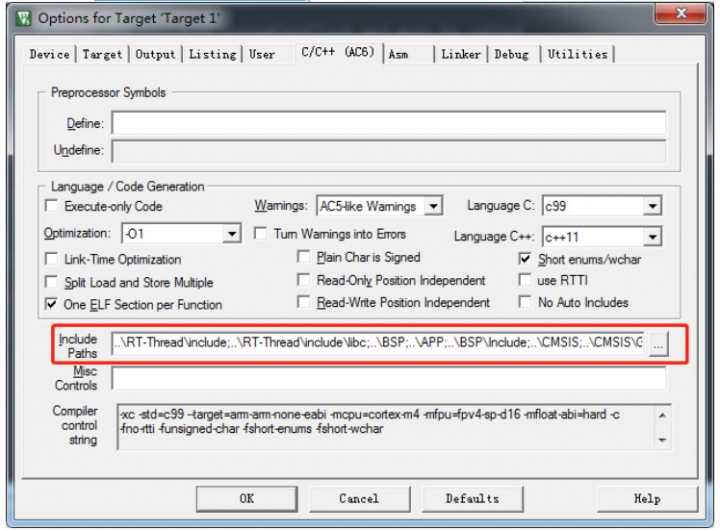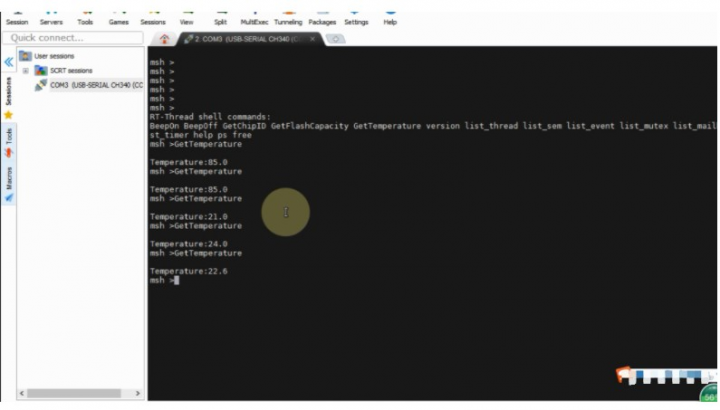
131 1300 0010

首先移植rtthread?nano,我使用的nano版本不是最新的,是3.1.3,建立工程架構以及添加頭文件路徑


修改一些配置,nvic_vector_table_set的定義和finsh所需要的串口的配置

void gd_eval_com_init(uint32_t com)
{
uint32_t COM_ID = 0U;
if(EVAL_COM == com){
COM_ID = 0U;
}else{
}
/* enable COM GPIO clock */
rcu_periph_clock_enable(EVAL_COM_GPIO_CLK);
/* enable USART clock */
rcu_periph_clock_enable(COM_CLK[COM_ID]);
/* connect port to USARTx_Tx */
gpio_af_set(EVAL_COM_GPIO_PORT, EVAL_COM_AF, COM_TX_PIN[COM_ID]);
/* connect port to USARTx_Rx */
gpio_af_set(EVAL_COM_GPIO_PORT, EVAL_COM_AF, COM_RX_PIN[COM_ID]);
/* configure USART Tx as alternate function push-pull */
gpio_mode_set(EVAL_COM_GPIO_PORT, GPIO_MODE_AF, GPIO_PUPD_PULLUP, COM_TX_PIN[COM_ID]);
gpio_output_options_set(EVAL_COM_GPIO_PORT, GPIO_OTYPE_PP, GPIO_OSPEED_10MHZ, COM_TX_PIN[COM_ID]);
/* configure USART Rx as alternate function push-pull */
gpio_mode_set(EVAL_COM_GPIO_PORT, GPIO_MODE_AF, GPIO_PUPD_PULLUP, COM_RX_PIN[COM_ID]);
gpio_output_options_set(EVAL_COM_GPIO_PORT, GPIO_OTYPE_PP, GPIO_OSPEED_10MHZ, COM_RX_PIN[COM_ID]);
/* USART configure */
usart_deinit(com);
usart_baudrate_set(com, 115200U);
usart_receive_config(com, USART_RECEIVE_ENABLE);
usart_transmit_config(com, USART_TRANSMIT_ENABLE);
usart_enable(com);
}
//實現該函數,才能使用rt_kprintf
void rt_hw_console_output(const char *str)
{
/* 進入臨界段 */
rt_enter_critical();
while(*str!='?')
{
/* 換行 */
if (*str == 'n')//RT-Thread 系統中已有的打印均以 n 結尾,而并非 rn,所以在字符輸出時,需要在輸出 n 之前輸出 r,完成回車與換行,否則系統打印出來的信息將只有換行
{
usart_data_transmit(USART0, 'r');
while(usart_flag_get(USART0, USART_FLAG_TC)== RESET);
}
usart_data_transmit(USART0, *(str++));
while(usart_flag_get(USART0, USART_FLAG_TC)== RESET);
}
/* 退出臨界段 */
rt_exit_critical(); //注意:使用進入臨界段語句rt_enter_critical(); 一定要使用退出臨界段語句 rt_exit_critical();否則調度器鎖住,無法進行調度
}
//使用Finsh組件三步驟:1.實現該函數及rt_hw_console_output函數;2.rtconfig.h中開啟RT_USING_FINSH宏;3.添加Finsh組件(cmd.c、msh.c、shell.c),
char rt_hw_console_getchar(void)
{
//查詢方式實現,記得將Usart1初始化中的中斷接收配置相關代碼注釋掉
int ch = -1;
/*等待串口1輸入數據*/
if(usart_flag_get(USART0, USART_FLAG_RBNE) != RESET)
{
ch = (int)usart_data_receive(USART0);
usart_flag_clear(USART0, USART_FLAG_RBNE);
}
else
{
if(usart_flag_get(USART0, USART_FLAG_ORERR) != RESET)
{
usart_flag_clear(USART0, USART_FLAG_ORERR);
}
rt_thread_mdelay(10);
}
return ch;
}
main函數創建一個led線程
#include
#include
#include "gd32f3x0_rcu.h"
#include "gd32f3x0_gpio.h"
#include "Uart.h"
static rt_thread_t led_thread;
void led_init(void)
{
/* enable the LED GPIO clock */
rcu_periph_clock_enable(RCU_GPIOA);
/* configure led GPIO port */
gpio_mode_set(GPIOA, GPIO_MODE_OUTPUT, GPIO_PUPD_NONE, GPIO_PIN_8);
gpio_output_options_set(GPIOA, GPIO_OTYPE_PP, GPIO_OSPEED_50MHZ, GPIO_PIN_8);
}
void led_thread_entry(void *parameter)
{
led_init();
while(1)
{
/* turn on led */
gpio_bit_write(GPIOA, GPIO_PIN_8, SET);
rt_thread_mdelay(2000);
/* turn off led */
gpio_bit_write(GPIOA, GPIO_PIN_8, RESET);
rt_thread_mdelay(2000);
}
}
void TaskInit(void)
{
led_thread = rt_thread_create("ledThread", /* 線程名字 */
led_thread_entry, /* 線程入口函數 */
RT_NULL, /* 線程入口函數參數 */
256, /* 線程棧大小 */
2, /* 線程的優先級 */
10 /* 線程時間片 */
);
if(led_thread != RT_NULL)
{
rt_thread_startup(led_thread);
}
}
int main()
{
TaskInit();
}
用GDlink下載代碼,用finsh可查看led線程創建成功。


同樣地,再創建一個ds18b20的讀取任務,ds18b20的溫度讀取流程:復位->發 SKIP?ROM?命令(0XCC)->發開始轉換命令(0X44)->延時->復位->發送 SKIP ROM 命令(0XCC)->發讀存儲器命令(0XBE)->連續讀出兩個字節數據(即
溫度)->結束。
貼出部分關鍵代碼
/*
*主機給從機發送復位脈沖
*/
static void DS18B20_Rst(void)
{
/* 主機設置為推挽輸出 */
DS18B20_Mode_Out_PP();
macDS18B20_DQ_0;
/* 主機至少產生480us的低電平復位信號 */
rt_hw_us_delay(750);
/* 主機在產生復位信號后,需將總線拉高 */
macDS18B20_DQ_1;
/*從機接收到主機的復位信號后,會在15~60us后給主機發一個存在脈沖*/
rt_hw_us_delay(15);
}
/*
* 檢測從機給主機返回的存在脈沖
* 0:成功
* 1:失敗
*/
static uint8_t DS18B20_Presence(void)
{
uint8_t pulse_time = 0;
/* 主機設置為上拉輸入 */
DS18B20_Mode_IPU();
/* 等待存在脈沖的到來,存在脈沖為一個60~240us的低電平信號
* 如果存在脈沖沒有來則做超時處理,從機接收到主機的復位信號后,會在15~60us后給主機發一個存在脈沖
*/
while( macDS18B20_DQ_IN() && pulse_time<100 )
{
pulse_time++;
rt_hw_us_delay(1);
}
/* 經過100us后,存在脈沖都還沒有到來*/
if( pulse_time >=100 )
return 1;
else
pulse_time = 0;
/* 存在脈沖到來,且存在的時間不能超過240us */
while( !macDS18B20_DQ_IN() && pulse_time<240 )
{
pulse_time++;
rt_hw_us_delay(1);
}
if( pulse_time >=240 )
return 1;
else
return 0;
}
/*
* 從DS18B20讀取一個bit
*/
static uint8_t DS18B20_ReadBit(void)
{
uint8_t dat;
/* 讀0和讀1的時間至少要大于60us */
DS18B20_Mode_Out_PP();
/* 讀時間的起始:必須由主機產生 >1us <15us 的低電平信號 */
macDS18B20_DQ_0;
rt_hw_us_delay(10);
/* 設置成輸入,釋放總線,由外部上拉電阻將總線拉高 */
DS18B20_Mode_IPU();
//rt_hw_us_delay(2);
if( macDS18B20_DQ_IN() == SET )
dat = 1;
else
dat = 0;
/* 這個延時參數請參考時序圖 */
rt_hw_us_delay(45);
return dat;
}
/*
* 從DS18B20讀一個字節,低位先行
*/
static uint8_t DS18B20_ReadByte(void)
{
uint8_t i, j, dat = 0;
for(i=0; i<8; i++)
{
j = DS18B20_ReadBit();
dat = (dat) | (j<>1;
/* 寫0和寫1的時間至少要大于60us */
if (testb)
{
macDS18B20_DQ_0;
/* 1us < 這個延時 < 15us */
rt_hw_us_delay(8);
macDS18B20_DQ_1;
rt_hw_us_delay(58);
}
else
{
macDS18B20_DQ_0;
/* 60us < Tx 0 < 120us */
rt_hw_us_delay(70);
macDS18B20_DQ_1;
/* 1us < Trec(恢復時間) < 無窮大*/
rt_hw_us_delay(2);
}
}
}
/**
* @brief 跳過匹配 DS18B20 ROM
* @param 無
* @retval 無
*/
static void DS18B20_SkipRom ( void )
{
DS18B20_Rst();
DS18B20_Presence();
DS18B20_WriteByte(0XCC); /* 跳過 ROM */
}
/**
* @brief 執行匹配 DS18B20 ROM
* @param 無
* @retval 無
*/
static void DS18B20_MatchRom ( void )
{
DS18B20_Rst();
DS18B20_Presence();
DS18B20_WriteByte(0X55); /* 匹配 ROM */
}
/*
* 存儲的溫度是16 位的帶符號擴展的二進制補碼形式
* 當工作在12位分辨率時,其中5個符號位,7個整數位,4個小數位
*
* |---------整數----------|-----小數 分辨率 1/(2^4)=0.0625----|
* 低字節 | 2^3 | 2^2 | 2^1 | 2^0 | 2^(-1) | 2^(-2) | 2^(-3) | 2^(-4) |
*
*
* |-----符號位:0->正 1->負-------|-----------整數-----------|
* 高字節 | s | s | s | s | s | 2^6 | 2^5 | 2^4 |
*
*
* 溫度 = 符號位 + 整數 + 小數*0.0625
*/
/**
* @brief 在跳過匹配 ROM 情況下獲取 DS18B20 溫度值
* @param 無
* @retval 溫度值
*/
float DS18B20_GetTemp_SkipRom ( void )
{
uint8_t tpmsb, tplsb;
short s_tem;
float f_tem;
DS18B20_SkipRom ();
DS18B20_WriteByte(0X44); /* 開始轉換 */
DS18B20_SkipRom ();
DS18B20_WriteByte(0XBE); /* 讀溫度值 */
tplsb = DS18B20_ReadByte();
tpmsb = DS18B20_ReadByte();
s_tem = tpmsb<<8;
s_tem = s_tem | tplsb;
if( s_tem < 0 ) /* 負溫度 */
f_tem = (~s_tem+1) * 0.0625;
else
f_tem = s_tem * 0.0625;
return f_tem;
}
